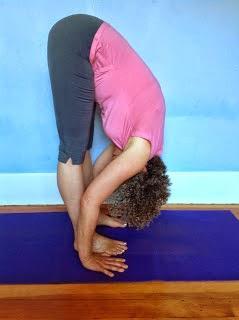
Standing Forward Fend (Uttanasana) is a staple of beginning-level practices as well as intermediate and advanced practices. Since we typically enter into the pose from Mountain pose, it usually shows up early in practices that focus on standing poses. It is also a transition pose in Sun Salutations.This pose stretches the muscles and fascial connective tissues along the entire back surface of the body. It opens the back buttock muscles and the hamstrings, as well as the back calf muscles. It also lengthens the long and more vertically oriented muscles that line the sides of the spine and neck area. It is considered a partial inversion, as the body is upside down from the hips to the head and has many of the benefits of the inverted poses (see All About Supported Inverted Poses).
I prescribe this pose for:- General tightness along the back of the body
- Tight hamstrings
- Resting pose between more vigorous standing poses
- Calming pose for stress and anxiety
- Improving lymphatic return from the pelvis to the heart
- Warming up for standing poses, inverted poses, twists, or seated forward bends
- In the supported version, for the benefits of inverted poses (triggering the Rest and Digest response)
Although it's not necessary to warm up for Standing Forward Bend, some people who are less flexible might benefit from a bit of movement first. From Mountain pose, inhale and take your Arms Overhead pose (Urdva Hastasana), exhale into Standing Forward Bend (maybe keeping your knees a bit bent first few times), inhale up to Arms Overhead pose, and exhale back to Mountain pose, about 4-6 times.
Classic Version of Standing Forward Bend
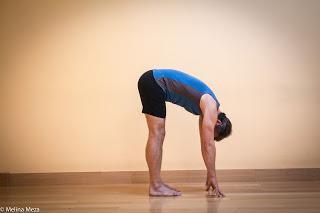 Start in Mountain pose with your feet about hips-distance apart and your hands on your hips. On an exhalation, tip forward from your hip joints, keeping the remainder of your spine in a neutral alignment, as you begin to come forward and down into the pose. When you feel your pelvis bones are no longer rolling forward over your upper thigh bones, allow the rest of your spine to gently flex forward and down until your hands or fingertips come to the floor in front of or next to your feet or when your back body stops you from going any further down. If your hands do not make it to the floor, you can place blocks under your hands so you are not over-efforting to get down all the way to the ground or you can bend your elbows and clasp opposite arms and let your arms release toward the floor.If you are very flexible or have a long torso with short legs and can easily bring your hands to the floor, bring your fingers in line with your toes and bend your elbows toward the wall behind you. Keep your arms, as well as the sides of your torso, strong and active, rather than just dangling from your hip joints.
Start in Mountain pose with your feet about hips-distance apart and your hands on your hips. On an exhalation, tip forward from your hip joints, keeping the remainder of your spine in a neutral alignment, as you begin to come forward and down into the pose. When you feel your pelvis bones are no longer rolling forward over your upper thigh bones, allow the rest of your spine to gently flex forward and down until your hands or fingertips come to the floor in front of or next to your feet or when your back body stops you from going any further down. If your hands do not make it to the floor, you can place blocks under your hands so you are not over-efforting to get down all the way to the ground or you can bend your elbows and clasp opposite arms and let your arms release toward the floor.If you are very flexible or have a long torso with short legs and can easily bring your hands to the floor, bring your fingers in line with your toes and bend your elbows toward the wall behind you. Keep your arms, as well as the sides of your torso, strong and active, rather than just dangling from your hip joints. 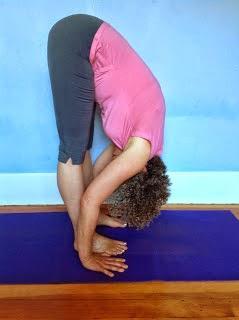 After you have aligned yourself in the pose, stay for a few breaths or up to 90 seconds. To come out of the pose, with strong legs, inhale and bring your spine to forward and up into a neutral alignment. Then engage the pelvis to spin up and back (retroversion) back to Mountain pose.First Variation: Bent Knees
After you have aligned yourself in the pose, stay for a few breaths or up to 90 seconds. To come out of the pose, with strong legs, inhale and bring your spine to forward and up into a neutral alignment. Then engage the pelvis to spin up and back (retroversion) back to Mountain pose.First Variation: Bent Knees 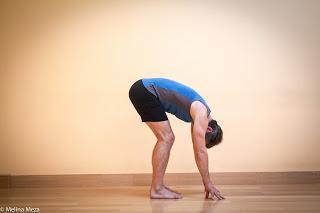 Enter and exit Standing Forward Bend as above except as you prepare to bend forward, allow your knees to bend forward a few inches and maintain this slight bend throughout your pose. This variation is helpful for newer practitioners and those with chronic tightness in the back body, including in the hamstrings, back buttocks, or lower back area. When you come back up, allow your knees to remain bent while keeping your legs active and strong. Once in Mountain pose, straighten your knees. Second Variation: Block between Thighs
Enter and exit Standing Forward Bend as above except as you prepare to bend forward, allow your knees to bend forward a few inches and maintain this slight bend throughout your pose. This variation is helpful for newer practitioners and those with chronic tightness in the back body, including in the hamstrings, back buttocks, or lower back area. When you come back up, allow your knees to remain bent while keeping your legs active and strong. Once in Mountain pose, straighten your knees. Second Variation: Block between Thighs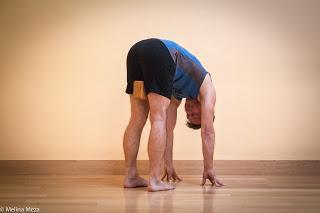 Using a block between your thighs can help add in strengthening of the inner thighs to the pose, as well as assisting you with focusing more attention on the movement of your pelvis over your thighs on the way in and out of the pose. Squeezing the block on the way up and out of the Standing Forward Bend can also assist your lower back and make the exit less stressful for your lower back muscles. Before you go into the pose, start in Mountain pose and pace the block on either its narrow or middle width between your mid-thighs, adjusting your feet so you can easily squeeze the block firmly with just a slight internal rotation of your thighs, as if you were going to roll the block slightly backwards. The key difference between this version and the full pose is to maintain the squeeze on the block through the entire pose. Otherwise, perform it as in the classic version above. Third Variation: Head and Arm Support
Using a block between your thighs can help add in strengthening of the inner thighs to the pose, as well as assisting you with focusing more attention on the movement of your pelvis over your thighs on the way in and out of the pose. Squeezing the block on the way up and out of the Standing Forward Bend can also assist your lower back and make the exit less stressful for your lower back muscles. Before you go into the pose, start in Mountain pose and pace the block on either its narrow or middle width between your mid-thighs, adjusting your feet so you can easily squeeze the block firmly with just a slight internal rotation of your thighs, as if you were going to roll the block slightly backwards. The key difference between this version and the full pose is to maintain the squeeze on the block through the entire pose. Otherwise, perform it as in the classic version above. Third Variation: Head and Arm Support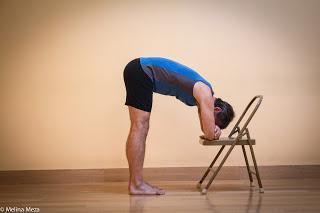 Standing Forward Bend is surprisingly quieting to your nervous system if you find a prop that is high enough so you can do the pose without feeling an uncomfortable stretch in your hamstrings. Using a chair is a great way to accomplish this. However, if you are very tight you may still need to bend your knees a bit to keep the entire pose quiet. Start by facing a chair, with the chair seat about one foot in front of you. If the chair has a hard seat, place a folded blanket or towel on it to make it a softer surface. Then come into the pose as in the classic version, but as you approach the chair seat, place your forearms on the seat of the chair and rest your head on the back of your stacked hands. Be mindful to rest your head on your arms or hands, and avoid pushing your head down forcefully. If your head doesn’t naturally come down to meet your hands, add a prop, such as a folded blanket or even a bolster, on top of the chair seat to raise your arms.Keep your legs somewhat active as releasing your body from hips to head onto the support of the chair, gradually working up to 1-2 minutes. To come out of the pose, bend your knees slightly and roll up slowly to Mountain Pose.
Standing Forward Bend is surprisingly quieting to your nervous system if you find a prop that is high enough so you can do the pose without feeling an uncomfortable stretch in your hamstrings. Using a chair is a great way to accomplish this. However, if you are very tight you may still need to bend your knees a bit to keep the entire pose quiet. Start by facing a chair, with the chair seat about one foot in front of you. If the chair has a hard seat, place a folded blanket or towel on it to make it a softer surface. Then come into the pose as in the classic version, but as you approach the chair seat, place your forearms on the seat of the chair and rest your head on the back of your stacked hands. Be mindful to rest your head on your arms or hands, and avoid pushing your head down forcefully. If your head doesn’t naturally come down to meet your hands, add a prop, such as a folded blanket or even a bolster, on top of the chair seat to raise your arms.Keep your legs somewhat active as releasing your body from hips to head onto the support of the chair, gradually working up to 1-2 minutes. To come out of the pose, bend your knees slightly and roll up slowly to Mountain Pose. Subscribe to Yoga for Healthy Aging by Email ° Follow Yoga for Healthy Aging on Facebook ° Join this site with Google Friend Connect

